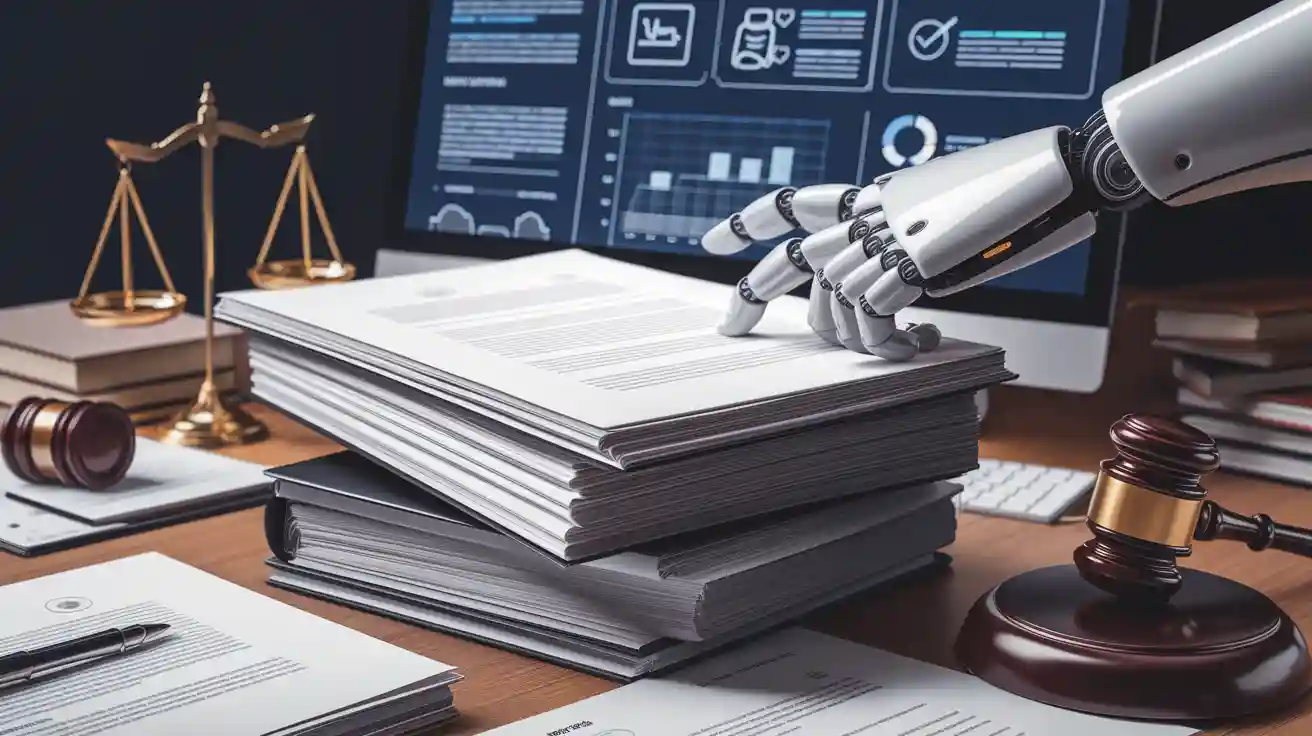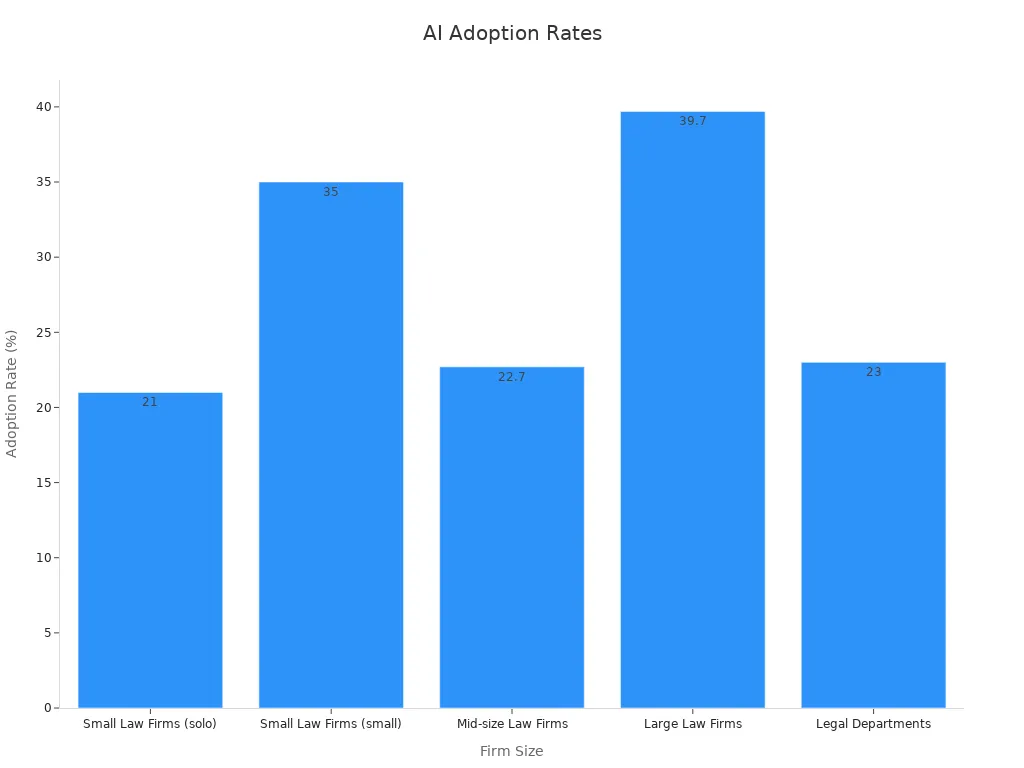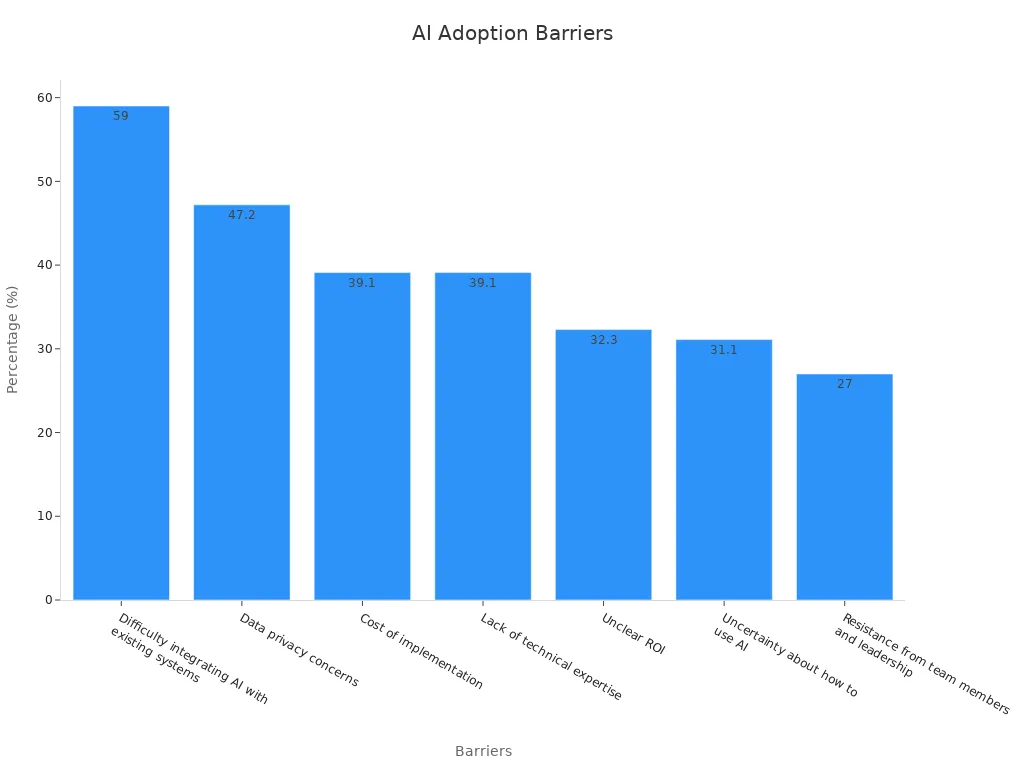
AI transforms legal document review with remarkable speed and precision.
|
Time Required Manually |
Time Required Using AI |
|
|---|---|---|
|
Document Review |
10 hours |
1 hour |
|
Contract Analysis |
5 hours |
30 minutes |
|
Data Entry |
2 hours |
15 minutes |
-
Machine learning and natural language processing power rapid analysis and reduce costly errors.
-
Law firms report lower costs, faster service, and improved accuracy.
Legal professionals now face new opportunities and challenges as they adapt and integrate AI into daily workflows.
Key Takeaways
-
AI speeds up legal document review, cuts costs, and improves accuracy, helping lawyers handle large workloads faster and with fewer errors.
-
Security and privacy risks rise with AI use, so law firms must enforce strong protections and clear policies to keep client data safe.
-
Successful AI adoption needs careful planning, staff training, and ongoing quality checks to boost productivity and maintain trust.
AI Transformation
Legal Document Review Today
Legal professionals face increasing pressure to manage large volumes of documents. Traditional legal document review often requires teams to manually sort, read, and analyze thousands of pages. This process can take days or even weeks, leading to high costs and the risk of human error. Many lawyers report that expanding data volumes create significant challenges. Surveys show that 60% of legal professionals struggle to keep up with the growing workload. Manual review also limits the time attorneys can spend on higher-level strategy and client service.
AI Impact
AI-powered tools now automate much of the document review process. These solutions analyze, summarize, and organize documents in minutes, not days. Lawyers can quickly identify key facts, track relevance, and uncover important patterns. The impact is clear:
-
54% of legal professionals report AI saves time and increases efficiency.
-
36% say AI improves the quality of their work.
-
Clio Duo users save up to five hours per week using AI tools.
-
Attorneys like Mechelle Woznicki and Melissa Oosterhof highlight faster preparation and instant data retrieval.

AI adoption rates continue to rise across all firm sizes. Firms that embrace AI gain a competitive edge through cost reduction, improved accuracy, and better client outcomes. Those who delay risk falling behind as the industry evolves.
Traditional Challenges
Manual Review Issues
Manual document review presents several persistent obstacles for legal teams. Many firms struggle to find enough skilled attorneys, especially those with foreign language skills or technical expertise. Rising costs for qualified staff and electronic data management stretch legal budgets. Teams often face tight deadlines, which increases pressure to review large volumes of unstructured data quickly. Errors and miscommunications occur frequently in multi-tiered manual reviews, leading to missed details or compliance risks. Security remains a concern, as data breaches and unauthorized sharing threaten sensitive information.
-
Difficulty in hiring skilled attorneys with language or technical skills
-
Rising costs for workforce and data management
-
Pressure from tight case deadlines
-
High error rates and miscommunications
-
Security risks from data breaches and poor controls
Collaboration and compliance also suffer. According to recent reports:
|
Challenge |
Reported Statistic |
Source/Context |
|---|---|---|
|
Collaboration issues |
Thomson Reuters Legal Trends Report |
|
|
Compliance risks |
54% |
EY's Corporate Counsel Survey |
|
Version control problems |
55% |
Contract Management Association report |
|
Poor document storage |
72% |
McKinsey & Company report |
|
Scalability issues |
61% |
Wolters Kluwer Corporate Legal Operations Survey |

Cost and Time Factors
Traditional review methods demand significant time and money. Firms often allocate large budgets to pay for manual labor and outside counsel. Processing times stretch as teams sift through thousands of pages. Recent data shows that technology can reduce costs per matter by 30-40% and cut review time by up to 60%. Document processing time drops by 40%, and outside counsel spending falls by nearly a third. These numbers highlight the inefficiency of manual processes and the urgent need for better solutions.
|
Metric Type |
Typical Improvement Range |
|---|---|
|
Cost per Matter |
|
|
Time Spent on Reviews |
40-60% reduction |
|
Document Processing Time |
40% reduction |
|
Outside Counsel Spend |
25-30% reduction |
|
Cost-per-Matter Efficiency |
33% improvement |
Note: Firms that continue to rely on manual review risk higher costs, slower turnaround, and increased error rates.
AI in Legal Document Review

Automation
AI-driven automation has transformed legal document review by handling repetitive and time-consuming tasks. Tools like CoCounsel, Briefpoint, and LawGeex now automate sorting, extraction, and summarization of legal documents. For example, CoCounsel can summarize lengthy contracts, generate event timelines, and draft legal content in minutes. One law firm partner reported that timeline creation, which once took weeks, now finishes in under seven minutes. Another legal counsel noted that drafting turnaround dropped from several days to just one or two. These tools allow lawyers to focus on strategy and client service instead of manual processing.
|
Organization |
AI Technology / Tool |
Automated Task(s) |
Impact / Outcome |
|---|---|---|---|
|
Lewis Roca Law Firm |
Casepoint AI-driven analytics |
Contract review, clause extraction |
Reduced review time, minimized human error, standardized reviews, increased throughput |
|
Becker & Poliakoff |
Litera contentCrawler (OCR) |
OCR conversion of image-based files |
Converted files to searchable PDFs, reduced processing time and costs, improved compliance |
|
Deutsche Bank |
WorkFusion platform (OCR + IDP) |
Processing unstructured documents |
Automated data extraction, reduced manual effort, enhanced compliance monitoring |
|
Thomson Reuters |
CoCounsel AI tool |
Summarization, timeline creation, drafting |
Accelerated legal research, improved document review efficiency, reduced turnaround time for drafting |
AI-powered automation also supports compliance checks. For instance, ContractSafe and LEGALFLY scan documents for regulatory requirements and flag potential issues. This reduces the risk of missing critical details and ensures that legal teams maintain high standards of accuracy.
Natural Language Processing
Natural language processing (NLP) enables AI to understand and interpret complex legal language. Tools such as ChatGPT, Harvey AI, and LawGeex use NLP to analyze contracts, identify key clauses, and compare documents against predefined criteria. These systems provide real-time feedback and suggestions for contract changes, streamlining the review process.
-
Reduction in outside counsel expenses
-
Increased capacity for high-value legal work
-
Improved accuracy in contract review and legal research
-
Enhanced user satisfaction within legal teams
NLP-powered platforms can also handle multilingual contract analysis, which accelerates decision-making for global firms. By automating the identification and evaluation of relevant clauses, these tools reduce manual effort and improve the quality of legal assessments. Integration with business systems, such as CRM and ERP, further streamlines workflows and supports faster compliance monitoring.
Predictive Analytics
Predictive analytics uses AI to forecast outcomes and prioritize documents for review. MyCase and LawGeex, for example, leverage predictive models to identify documents most likely to be relevant in a case. This approach helps legal teams allocate resources efficiently and focus on high-priority materials.
AI agents dynamically analyze contracts, adapt to new data, and continuously optimize recommendations. Real-time analytics enable faster compliance reporting and risk assessment. By reducing the volume of documents needing manual examination, predictive analytics shortens review cycles and improves overall efficiency.
Tip: Predictive analytics not only accelerates legal document review but also enhances decision-making by highlighting patterns and trends that might otherwise go unnoticed.
eDiscovery
eDiscovery platforms powered by AI, such as DocuSign and Casepoint, have revolutionized the way legal teams manage large-scale investigations. These tools use technology-assisted review and predictive coding to sift through millions of documents quickly. In the Da Silva Moore v. Publicis Groupe case, predictive coding reviewed only 1.9% of 3 million documents, achieving 86% accuracy and reducing review time and costs by over 60%. JP Morgan’s COIN platform automated contract review, saving approximately 360,000 lawyer hours annually.
-
Predictive coding with Continuous Active Learning prioritizes relevant documents.
-
Technology-assisted review matches or exceeds human accuracy with less manual effort.
-
Courts now endorse AI methods for eDiscovery, recognizing substantial time and cost savings.
AI-powered eDiscovery ensures that legal teams can meet tight deadlines, reduce costs, and maintain high standards of accuracy. As a result, legal document review becomes more manageable, even in the most complex cases.
Benefits

Speed and Efficiency
AI dramatically increases the speed and efficiency of legal document review. In a recent multinational investigation, Control Risks used an AI-powered solution that reduced first-level review costs by about 50% and cut total review time by nearly 80%. The Enron case demonstrated AI’s ability to process 1.6 million emails, showing its strength in handling large volumes. The following table highlights the improvements after AI implementation:
|
Metric |
Before AI |
After AI Implementation |
|---|---|---|
|
Research Time |
4 hours/case |
|
|
Document Processing |
100 pages/hour |
Over 1,000 pages/hour |
|
Increased Case Capacity |
Baseline |
30% more cases |
A study also found that AI reviewed five NDAs in just 26 seconds, while lawyers took an average of 92 minutes.
Accuracy and Consistency
AI tools improve accuracy and consistency in legal evaluations.
-
AI-based systems filter millions of documents for relevance, reducing costs and errors.
-
Contract analysis platforms identify clauses and risks, ensuring faster and more consistent reviews.
-
Predictive analytics guide legal strategies by analyzing past case outcomes.
-
Machine learning and NLP tag complex legal terms more accurately than manual methods.
-
Hybrid approaches, combining AI and human review, enhance reliability and precision.
Cost Reduction
AI integration leads to significant cost savings.
-
Legal review fees can decrease by as much as 50%.
-
McKinsey estimates that 60% of legal work is automatable, offering major potential for savings.
-
Automated workflows reduce manual labor, errors, and compliance risks.
Workflow Improvement
AI adoption streamlines legal workflows and boosts productivity.
-
AI speeds up data extraction, document Q&A, summarization, and transcript analysis.
-
High-ROI workflows like clause extraction benefit most from early AI implementation.
-
Even when AI does not outperform lawyers in accuracy, its speed makes it valuable as a first-pass tool.
-
Studies show that AI reduces task completion time by 12-37% and increases productivity by up to 140% in complex assignments.
Note: Most legal teams use AI to augment, not replace, human skills, leading to more effective and efficient workflows.
Challenges
Data Privacy
Law firms handle confidential client information, privileged communications, and sensitive business data. AI-powered tools can increase the risk of unauthorized access or data breaches if not properly secured. Firms must use strong data protection measures, such as encryption and strict access controls. Compliance with regulations like GDPR and CCPA remains essential. Industry standards require that AI systems preserve the integrity of legal practice. Balancing AI efficiency with robust privacy safeguards is now a top priority for legal teams.
-
Legal documents often contain highly sensitive data.
-
AI tools may expose information if security is weak.
-
Firms should use encryption and limit access.
-
Compliance with privacy laws is mandatory.
-
Strong privacy practices protect client trust.
Security
Security risks grow as more firms adopt AI. Employees sometimes use unapproved AI tools, known as Shadow AI, which can lead to data leaks. Over 70% of AI tool use at work comes from non-corporate accounts, exposing sensitive data without proper oversight. Real-world incidents, such as the Samsung data breach involving ChatGPT, show the dangers of mishandling confidential information. Insider threats, both accidental and intentional, account for about 60% of data breaches. Weak access controls and poor data classification make these risks worse. Ransomware attacks, now more common due to AI, have increased by 8% in North America. Firms should set clear AI policies, use Data Loss Prevention filters, and enforce strict governance to reduce these threats.
Adoption Barriers
Despite AI’s promise, many firms face obstacles when integrating new technology. According to recent reports, 77% of legal professionals expect AI to transform their work, but concerns remain. Ethical issues, training needs, and the challenge of ensuring AI supports rather than replaces human judgment are common. About 43% of those who have not used AI worry about the quality of its outputs, and 37% cite data protection as a concern. Only 4.3% of legal professionals find AI adoption easy. The table below highlights the main barriers:
|
Barrier to AI Adoption |
Percentage of Respondents |
|---|---|
|
Difficulty integrating AI with existing systems |
59% |
|
Data privacy concerns |
47.2% |
|
Cost of implementation |
39.1% |
|
Lack of technical expertise |
39.1% |
|
Unclear ROI |
32.3% |
|
Uncertainty about how to use AI |
31.1% |
|
Resistance from team members and leadership |
27% |
Nearly all legal professionals agree that human oversight and clear internal rules are necessary for responsible AI use.

Best Practices
Needs Assessment
Legal teams should start by evaluating their current workflows and identifying repetitive tasks that slow down productivity. They need to determine which processes would benefit most from automation. Teams often find that routine document sorting and data extraction take up valuable time. By mapping out these tasks, they can set clear goals for AI integration.
Tool Selection
Selecting the right AI tool requires careful planning. Teams should check if the new system works well with existing legal software. IT professionals play a key role in managing system requirements and ensuring strong security protocols. Firms must also coordinate with vendors to address compatibility and support needs. A hybrid approach, where AI handles routine work and lawyers focus on complex analysis, often delivers the best results.
Training
Comprehensive training helps staff adapt to new AI tools. Change management strategies, such as open communication and setting realistic expectations, ease the transition. Firms should provide ongoing support and encourage feedback from users. Training sessions should cover both technical skills and workflow changes. This approach builds confidence and increases adoption rates.
Quality Monitoring
Quality control remains essential for successful AI use. Teams should implement validation procedures, regular accuracy testing, and audit trails. Error correction mechanisms help maintain high standards. Continuous improvement comes from routine system updates, user feedback, and monitoring compliance with legal standards. Regular reviews ensure that AI tools deliver reliable and accurate results.
Tip: Combining robust quality checks with ongoing training creates a strong foundation for effective AI integration.
Future Trends
Generative AI
Generative AI continues to reshape the legal industry. Experts predict steady progress in the adoption of generative AI through 2025. Law firms and legal departments focus on refining current technologies and integrating AI into daily tasks such as drafting, contract analysis, and litigation prediction. Surveys show that large language models are gaining traction in legal work, with spending on legal AI expected to increase three to five times in the coming years. Legal professionals now use generative AI to amplify their impact, not replace their roles. Many firms invest in training, including prompt engineering, to help teams use these tools effectively. Ethical AI governance and strong data hygiene practices become essential as organizations automate more legal tasks.
Evolving Legal Roles
The rise of AI transforms legal roles and team structures. Deloitte Legal’s research finds that almost half of legal departments expect their size to remain stable, but team composition and skill sets will change. Only 27% of chief legal officers believe their teams have the right mix of skills. Firms now seek hybrid experts who understand both law and AI. New positions, such as AI implementation managers, emerge to guide technology adoption. Legal professionals must develop AI literacy and decision-making skills to stay competitive. As AI automates routine work, teams may see an increase in seniority and a shift toward more strategic tasks. Governance frameworks and external partnerships help legal functions maximize AI’s potential.
AI delivers measurable value in legal document review. Legal teams benefit from:
-
Automated due diligence and contract compliance
-
Streamlined billing and time tracking
-
Enhanced client support and e-discovery
Firms should embrace AI, adapt workflows, and invest in ongoing learning to stay competitive.
FAQ
What types of legal documents can AI review?
AI reviews contracts, discovery documents, NDAs, compliance forms, and court filings. Many platforms support multiple formats and languages for global legal teams.
How does AI ensure accuracy in document review?
AI uses machine learning and natural language processing. These technologies identify key terms, flag inconsistencies, and compare documents against legal standards.
Is AI secure for handling confidential legal data?
Most legal AI tools use encryption, access controls, and compliance protocols. Firms should verify security certifications and monitor usage to protect sensitive information.








